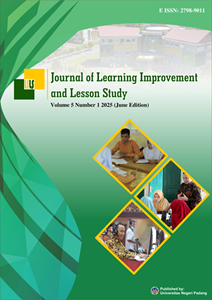Development of a Narrative Writing Skills Assessment Rubric through Differentiated Instruction for Junior Secondary School
DOI:
https://doi.org/10.24036/jlils.v5i1.148Keywords:
Assessment Rubric, Narrative Writing, Differentiated Instruction, Kurikulum Merdeka, Junior Secondary SchoolAbstract
The development of a narrative writing assessment rubric based on differentiated instruction serves as a solution to the need for an evaluation instrument that is responsive to the diversity of junior high school students. Using the Research and Development (R&D) approach by Borg & Gall, the rubric was designed with five assessment dimensions and validated by experts. Reliability testing was conducted using Cohen’s Kappa, and its effectiveness was examined through a paired t-test. The results showed a significant improvement in the quality of students’ writing, particularly in text structure and grammar. Questionnaire and interview data further confirmed that the rubric provided clarity in assessment and increased student motivation and participation. Teachers found the rubric helpful for conducting objective and consistent evaluations. This rubric supports the implementation of the Kurikulum Merdeka, which emphasizes an inclusive and differentiated instructional approach.
Keywords: Assessment Rubric, Narrative Writing, Differentiated Instruction, Kurikulum Merdeka, Junior Secondary School
References
Aiken, L. R. (1985). Three coefficients for analyzing the reliability and validity of ratings. Educational and Psychological Measurement. 45(1), 131–142.
Andrade, H. G. (2005). With Rubrics: The Good, the Bad, and the Ugly. College Teaching. 53(1), 27–30.
Biggs, J., & Tang, C. (2007). Teaching for quality learning at university (3rd ed.). Open University Press.
Borg, W. R., & Gall, M. D. (2003). Educational research: An introduction (7th ed.). Pearson Education.
Brookhart, S. M. (2013). How to create and use rubrics for formative assessment and grading. ASCD.
Brown, H. D. (2007). Teaching by principles: An interactive approach to language pedagogy (3rd ed.). Pearson Education.
Ferris, D. R. (2003). Response to student writing: Implications for second language students. Lawrence Erlbaum Associates.
Harmer, J. (2007). The practice of English language teaching (4th ed.). Pearson Longman.
Hyland, K. (2003). Second language writing. Cambridge University Press.
Nation, I. S. P. (2009). Teaching ESL/EFL reading and writing. Routledge.
Nitko, A. J., & Brookhart, S. M. (2014). Educational assessment of students (7th ed.). Pearson Education.
Popham, W. J. (2017a). Assessment for learning: An action guide for school leaders. ASCD.
Popham, W. J. (2017b). Classroom assessment: What teachers need to know (8th ed.). Pearson Education.
Tomlinson, C. A. (2014). The differentiated classroom: Responding to the needs of all learners (2nd ed.). ASCD.
Zhang, S. (2011). The role of rubrics in writing instruction and assessment. Journal of Education and Practice. 2(3), 29–35.





